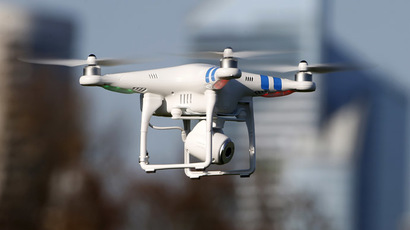'It's a warzone in the US': Indiana sheriff explains why he deployed heavy armor in his county
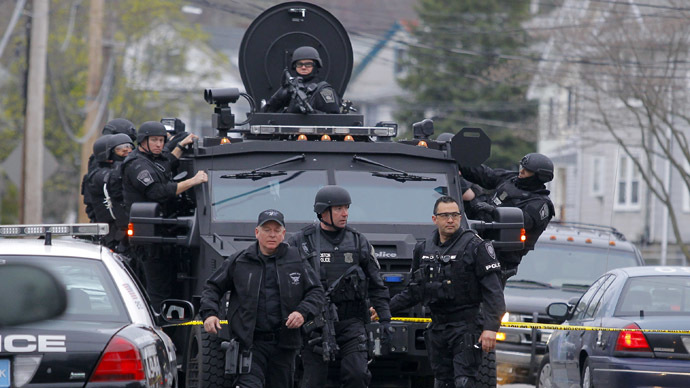
From the streets of Fallujah to Franklin, Indiana, heavily armored military vehicles have been rolled out for one and the same reason: many police officers in the US believe there’s a war going on.
Franklin, Indiana is by all accounts the idyllic Midwestern American town. Eponymously named after one of the founding fathers and “the first American,” Franklin’s small town bona fides provided Life Magazine with a Norman Rockwell-esque scene for a bit of village life utopia in the heart of the Great Depression.
But if you were to talk to local law enforcement, a battle is raging in the streets of Mayberry.
Franklin is the county seat of Johnson Country, Indiana. Speaking with Mark Alesia from The Indianapolis Star, Sheriff Doug Cox described the 139,000-strong administrative district as a place where officers' old-time policing just doesn’t cut it anymore.
Leading Alesia to a pole barn in Franklin, Cox shows him a MRAP – a 55,000 pound, six-wheeled Mine-Resistant Ambush Protected armored-fighting vehicle with the word “SHERIFF" emblazoned on its flank.
“We don't have a lot of mines in Johnson County," confessed Sheriff Doug Cox, who acquired the vehicle. "My job is to make sure my employees go home safe."
Cox isn’t alone in believing his deputies have something to fear. Johnson County is one of eight Indiana law enforcement agencies to acquire MRAPs from military surplus since 2010, according to public records obtained by The Indianapolis Star.
All across the state, and the country, the trend is similar. From picking up military surplus to using to $35 billion in grants from the Department of Homeland Security to acquire the most advanced weapons, police forces across America are armed to the teeth.
And as Pulaski County Sheriff Michael Gayer puts it, the effects are not only tactical, but psychological.
To put it bluntly: "It's a lot more intimidating than a Dodge."
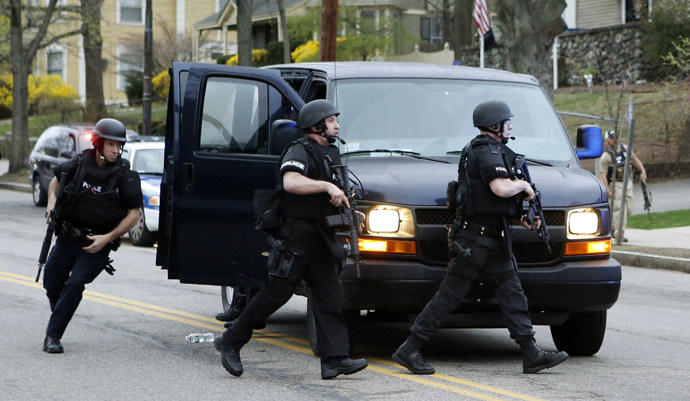
Pulaski, mind you, is a county of roughly 13,000 people. The question of whether civilians need to be intimidated like that depends on your perspective, and as far as Gayer sees things, America is a battlefield and the police are akin to an occupying force.
"The United States of America has become a war zone," he said. "There's violence in the workplace, there's violence in schools and there's violence in the streets. You are seeing police departments going to a semi-military format because of the threats we have to counteract. If driving a military vehicle is going to protect officers, then that's what I'm going to do."
‘What if it were your kid’
The militarization of America was covered in a recent Vice.com documentary, entitled: ‘Here's What Happens When Hackers Send a SWAT Team to Your House.’
Vice's Danny Gold heads to Somerset County, New Jersey, what he describes as “one of the wealthiest counties in the US.”
Sgt. Edward Ciempola, commander of the county SWAT team, boasts of a Lenco BearCat Ballistic Engineered Armored Response Counter Attack Truck, which he says they use on “every call out.”
With infrared cameras in stock and other military grade hardware, Gold asks Ciempola one simple question: in a quiet, relatively crime-free area, is all of this hardware really necessary?
“I would ask somebody that maybe suffered a loss because of not having this service and I would ask them the answer to that question,” Ciempola said.
“I would say, well, the SWAT team wasn’t available when you really needed it or a police officer wasn’t available when you really needed it, or an ambulance didn’t get there when you really needed it. How does that make you feel? And if your child’s school was suddenly under attack by some random actors, do you want them coming (points to SWAT team) to help your kid or do you want no one to show up?”
Despite the fears of Ciempola and Gayer, in a 2012 Department of Justice report, violent crime had declined by 72 percent from 79.8 to 22.5 per 1,000 persons age 12 or older since 1993. And yet, what’s happening in places like Franklin and Somerset County are far from anomalous.
Writing for the Huffington Post, Radley Balko noted the disturbing trend in SWAT team growth across the country.
He argues that SWAT teams in municipalities with populations between 25,000 and 50,000 have “increased by more than 300 percent between 1984 and 1995.”
By 1995, nearly 90 percent of cities with 50,000 or more people had a SWAT team. In 2000, 75 percent of towns with 25,000 to 50,000 people had their own SWAT teams as well. And those paramilitary units are not sitting idly by.
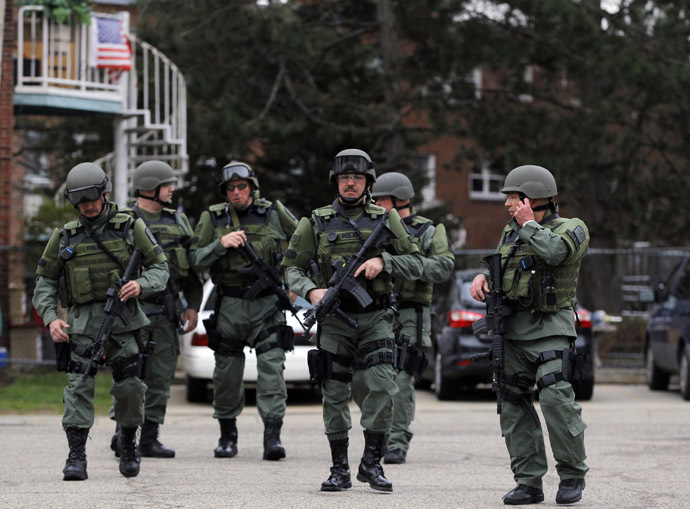
Citing Peter Kraska, a criminologist at Eastern Kentucky University, Balko says the total number of SWAT raids in America has increased exponentially, from just a few hundred per year in the 1970s, to a few thousand by the early 1980s, to around 50,000 by the mid-2000s.
According to the American Civil Liberties Union (ACLU), “disproportionately those in poor communities and communities of color – have become targets for violent SWAT raids, often because the police suspect they have small amounts of drugs in their homes.”
And with the SWAT teams comes the military hardware. In Keene, New Hampshire, a town with two murders since 2009, officials accepted a $285,933 grant from the Department of Defense in 2012 to purchase a BearCat. In Columbia, South Carolina, a MRAP which can be equipped with a 50-caliber machine gun was picked up in 2013. In the sleepy town of Roanoke Rapids, North Carolina – a town of 16,000 people, police got their hands on their own Humvees and MRAPs, which they went on to display at a car show.
According to March report in USA Today co-written by US Representative Hank Johnson, the following counties “have acquired free MRAPs from US war zones”:
McLennan and Dallas Counties in Texas; Boise and Nampa Counties in Idaho; Indiana's West Lafayette, Merrillville, and Madison Counties in Indiana (not to mention Johnson); Minnesota's St. Cloud and Dakota Counties in Minnesota; Warren and Jefferson Counties in New York; North Augusta and Columbia in South Carolina; Murfreesboro in Tennessee; Yuma in Arizona; Kankakee County in Illinois; and Calhoun County in Alabama.
Many of the vehicles were acquired through the 1033 program, a 1997 law which facilitated the transfer of military hardware to local police forces. But what appears to be free federal handouts could result in fundamentally changing the face of the United States.
“Americans should therefore be concerned, unless they want their main streets patrolled in ways that mirror a war zone,” Johnson lamented.
“We recognized that we're not in Kansas anymore, but are MRAPs really needed in small-town America? Are improvised explosive devices, grenade attacks, mines, shelling and other war-typical attacks really happening in Roanoke Rapids, a town of 16,000 people? No.”
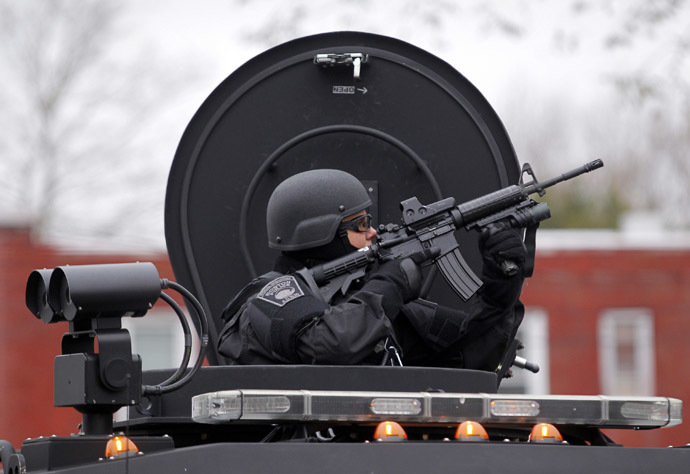
Johnson, a member of the House Armed Services and Judiciary Committees, announced he was introducing legislation to reform the 1033 program “before America's main streets and civilian police militarize further.” The ACLU, meanwhile, has launched an investigation into the militarization of US police.
“The police officers on our streets and in our neighborhoods are not soldiers fighting a war. Yet many have been armed with tactics and weapons designed for battle overseas,” it said.
In 2013, ACLU affiliates in 25 states filed over 260 public records requests with law enforcement agencies to document the impact of excessively militarized policing on people, families, and communities.
But as Balko warns, vested interests are likely to keep pushing the police-industrial complex until America is on lockdown.
"A new industry appears to be emerging just to convert those grants into battle-grade gear," he said.
"That means we'll soon have powerful private interests, funded by government grants, who will lobby for more government grants to pay for further militarization — a police industrial complex."
William Echols,
RT














